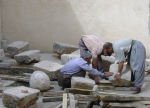Paikoli Monument(1) was probably formed by a quadrilateral stone wall (average size: 40 x 60 x 40 cm) filled with a concrete mix of river stones and pebble; the binder of the concret e mix is probably calcium bi-hydrated sulphate (gypsum). Every block shows in the upper face two holes about 5 cm wide and about 3 cm deep, certainly used for the insertion of cramps to connect one block to the two adjacent. Very few traces of metal (iron) are visible on some blocks and probably the metal cramps, due to their oxidation, have detached parts of the stone widening the holes. No lead flowing canals are visible near the cramps housings; this evidence suggests that the cramps have been used for the alignment of the blocks during the building phase, more than for structural reasons.
Some of the blocks are inscribed, some are moulded6, all the others, the majority, have one flat quadrilateral face, the two couples of faces adjacent to the flat one are parallel and the face opposite to the flat one is roughly worked in pyramidal shape.
The stone used for the blocks is soft chalky limestone (analysis on the stone will be performed in Italy on samples from Paikoli area were, with no doubts, the blocks were carved).
The working signs still visible on the stone8 show that the stone workers used hammers and chisels for the rough-shaping and tooth and point chisels and bush hammers for the finishing of the flat ext ernal face. The inscription does not show the working signs anymore.
In the valley where Paikoli is situated, very strong winds blow, carrying siliceous sand at a great speed. This cause a sanding effect, which consequences are clearly visible on the blocks of the monument 9 and on the non-worked (natural) stones about the archaeological site. So there is a great di fference between weathering that environment caus ed to blocks faces that were in contact with the ground and that one caused to the faces that were expos ed to the wind.
The faces exposed to wind, not only are eroded, but show craters and worm-shaped canals. This kind of erosion is probably due to micro-whirls formed inside the natural cavities of the stone that multiplied the speed of wind. On some blocks is clearly visible bio-degradation mostly due to the pres ence of algae, lichens, fungi and cyanobacteri as colonies. The stone of most of the blocks is sound and structurally well preserved, anyway some blocks present fractures 11 or missing parts; this is probably due to the collapse of the monument or to its dismantling.
The gypsum-based concrete shows weathering due to the fact that gypsum is hygros copic and soluble; this, during the rainy days, caused the solution of gypsum in water, and gypsum re-crystallization during wat er evaporation. The recrystallization took place near the pebbles 12 that form part of the gypsum concrete. In this way the gypsum matrix of the concrete lost part of its aggregation power.
For security reasons all the moulded blocks and all the inscribed blocks that were found during this first excavation phase have been transported to the Sulemani Museum.
Note:
1: Paikuli is a Parthian-Sassanian monument and it is famous because of a Parthian and sassanian inscriptions found there. For more information please see (http://www.iranicaonline.org/articles/herzfeld-ernst-iv)
Please read this article in attached PDF file
| Attachment | Size |
|---|---|
| Paikuli_a_Italian-Kurdish_project_2006.pdf | 8.36 MB |

